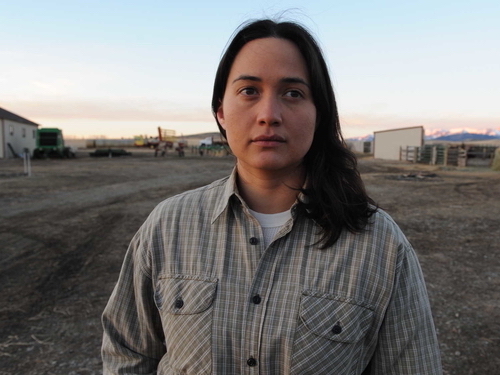
The lives of three women intersect in small-town America.
“But there is a fourth woman, the Indian rancher who, one day, without knowing why, walks into that classroom. In a way, I would say that she is really the character who stands out, because she is not simply a sociological character. Nor is she here to show loneliness or desperation. She is a character who is perfectly adapted to her routine but who, at a certain moment, deviates from her normal life. You see her doing her job, and doing it well. In the classroom, though, she sees this elegant lady from the big town. She’s fascinated, and that last story is about this fascination, which at the end turns out to be deceived. There is a kind of imbalance in the role played by all these women: three of them attest to a certain state of social reality in a certain geographical zone. But this other character is a real cinematographic character, a character in line with some other characters in the history of cinema. I’m thinking of The Postmaster from the anthology film Teen Kanya [Three Daughters] (1961), by Satyajit Ray, which has a young girl who works a servant for the postman who starts teaching her to read and write, but at the end he leaves. It is the same kind of one-way love story, because the other one, the learned person, is absolutely unable to see what is at play in their relation. In both cases, it is the illiterate person who is able to feel something different, to get out of her line. In most cases, characters of this sort, who are faithful to a deviation, are women: think about Ginnie in Vincente Minelli’s Some Came Running (1958), or about girls like Estike, in Bela Tarr’s Sátántangó (1994).”
Stoffel Debuysere in conversation with Jacques Rancière1
“Kelly Reichardt’s Certain Women opens with a train moving slowly towards the camera. Its relentless motion announces a film borne along on a sense of the inevitable daily grind, carrying us into the heartlands of southern Montana: a place of pines and sandstone, traversed by tarmac roads that are unlit and unbordered, and spotted with small urban centres made up of flat-roofed diners and mini-malls, the names of which the film chants like an incantation: Three Forks. Glendive. Missoula. Billings. Livingston.”
Catherine Wheatley2
“Around the four sharply observed character studies, the landscape lingers without pressing in, to be picked over by acquisitive Gina, worked on by the rancher or traversed by the exhausted Beth. Visible through every window and car journey, the Montana mountains preside over everything. Shot by long-time Reichardt collaborator Christopher Blauvelt in 16mm, giving grain and subtle texture to the film’s slate-and-beige palette, they have a painterly look that’s never overworked. There’s a hint of Milton Avery’s blocky landscapes about them, as Reichardt has acknowledged. Looming large, they add to the film’s discreet echoes of north-western history, successive inhabitants signalled by the costumed Native Americans dancing in the mall or Gina’s townie hunger for the original sandstone blocks that were once the frontier schoolhouse. A meticulous natural soundscape underlines all of this, its outdoor silences embroidered almost imperceptibly with river splashes, birdsong, wind in the trees and the distant hum of a car.”
Kate Stable3
“Kelly Reichardt’s Certain Women was the best film I saw this year in Park City, and is sure to wind up on my shortlist of the year’s truly beautiful things. Reichardt has tended to train her attention on subjects trying, and inevitably failing, to navigate the world outside of the established order. Her adaptation here of three short stories from Maile Meloy’s Both Ways Is the Only Way I Want It – simple portraits of women trying to live their lives, fulfill their desires, and maintain or manufacture some idea of happiness – may be nothing more or less than an object of pure dignity, a film about the joys and virtues of being a woman and making films about the experience(s) of being a woman. Christopher Blauvelt’s gauzy 16mm photography, conjuring Whistlers and Vermeers, distresses Reichardt’s overcast Americana in a slumbrous grace, producing effortlessly wistful images from the sheer banality of freight trains, smeared mirrors, and barnyards, while elsewhere Lily Gladstone delivers one of the great screen performances I’ve seen in any movie, and does so without saying more than a few words. There may be a dense underlying sorrow running through every frame of this picture – coasting on the essence of silence and silencings – but its impact arouses something closer to the satisfaction of a victory, the auspicious approach of some tipping point or other that, were it to ever arrive, would likely have the means to split our ears.”
Blake Williams4
- 1Stoffel Debuysere, “On the Borders of Fiction. A Conversation with Jacques Rancière,” Sabzian, 20 September 2017. [This conversation took place at Courtisane Festival 2017. Discover the whole transcription at Sabzian using the link above. “During this conversation, a selection of recent film works served as a starting point for an exploration of the relations between cinema and fiction, and the workings of fiction in the art of cinema.”]
- 2Catherine Wheatley, “Certain Women review: a landscape of restraint,” Sight and Sound (BFI Online), 7 June 2017
- 3Kate Stable, “Certain Women: Kelly Reichardt’s Minimalist Montana Triptych,” Sight and Sound, March 2017
- 4Blake Williams, “Certain Women (Kelly Reichardt, US) — Masters,” Cinema Scope, 2016